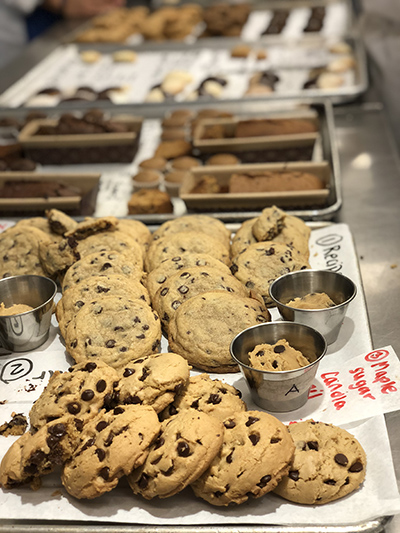ICE’s Health-Supportive Culinary Arts program dedicates 56 hours to baking and desserts, and students experiment with ingredient conversions for cookies and brownies for two very popular days of class. We asked Chef-Instructor Olivia Roszkowski for a primer on the realm of alternative sweeteners that her class explores and tips for working with the ingredients, including three sugars, two syrups and a nectar.
In Health-Supportive Culinary Arts, we teach students how to season their food, which frequently involves adding salt, sweetness, spice and acid. We stress variety in diet and discuss ancient traditions such as Ayurvedic cuisine, which focuses on the six tastes for balance.
We strive to teach our students techniques, particularly the art of baking in Module 3. Our mantra is utilizing whole, minimally processed foods, so in addition to stressing the involvement of whole grains, we educate about using sweeteners that are minimally processed and contain minimal additives. Date sugar contains minerals, dates contain fiber and raw honey has enzymes. All of our sweeteners are plant-based except for honey.
Here are seven sweeteners with tips for baking and hacks for making snacks.
- Maple syrup: the boiled down sap of sugar maple trees. It takes 35-50 gallons of sap to make one gallon of syrup.
- Brown rice syrup: Soaking and fermenting rice activates enzymes to modify starches into sugars, which are later strained and boiled down into a syrup.
- Maple sugar: Evaporated maple syrup is made from the controlled crystallization of pure syrup and has a sweetness equivalent to white sugar.
- Coconut sugar: made from the nectar from the palm of the coconut tree and can range in color depending on the cooking caramelization time.
- Organic cane sugar: strong but neutral in flavor, it is purely crystalline which means that it melts to a liquid over heat and emulsifies easily with other liquid ingredients. It is also hygroscopic, which allows it to attract and hold on to moisture.
- Agave nectar: filtered, reduced juice from several varieties of the cactus family that lends a light color and neutral taste to baked goods.
- Date sugar: ground, dried dates that works great in wet batters like flourless chocolate cake or truffle batter.
Study Health-Supportive Culinary Arts
 Alternative Sweetener Tips
Alternative Sweetener Tips
Chef Olivia recommends organic or non-genetically modified brands for the highest quality ingredients. To replace the sweetener in a recipe with one of the options above, start with a 1-to-1 ratio, tasting for sweetness level and reducing liquid ingredients when using a liquid sweetener. Remember:
- Liquid sweeteners cannot be creamed and create a more cakey, softer baked good.
- Dry sweeteners hold in more moisture.
- Add more moisture when using coconut or date sugar to prevent dry cookies.
- Brown sugar has acid, so when removing and replacing it in recipes, make sure to increase baking powder or cream of tartar to ensure a rise.
- Add a drop of stevia to sweetener of choice to intensify sweetness level.
- Grind and make sure to sift larger granules to help with emulsification.
- Press down cookie dough, as natural sweeteners have bigger molecules and can create denser products.
- Reduce oven temperatures to avoid dark color.
Quick Hacks with Additional Sweeteners
Here are five things you can make with alternative sweeteners.
Foolproof coconut caramel: Simmer 1 cup coconut sugar with a can of coconut milk.
Quick fruit jam: Simmer dried fruit like figs or apricots in juice and puree with a hand blender.
Instant cookie dough: Mix equal parts coconut sugar and nut butter for quick dough that you can also bake. You can add flavor with a teaspoon of baking powder, a pinch of salt and any spices you like, such as ginger, vanilla or cinnamon.
Plant-based honey: Reduce down apple cider or juice until it reaches a syrup consistency.
Date puree: Blend pitted dates with hot water or coconut milk for a natural fruit sweetener.






